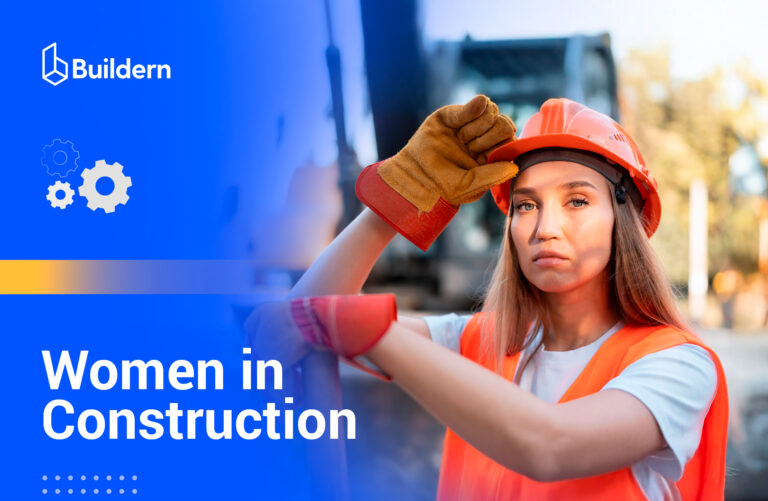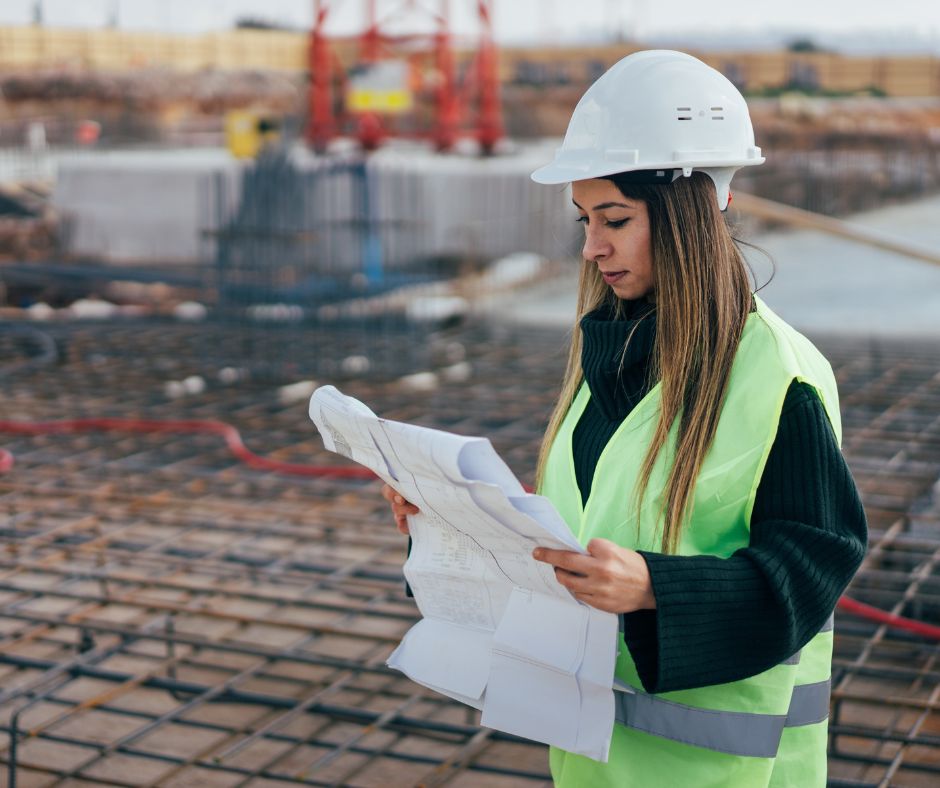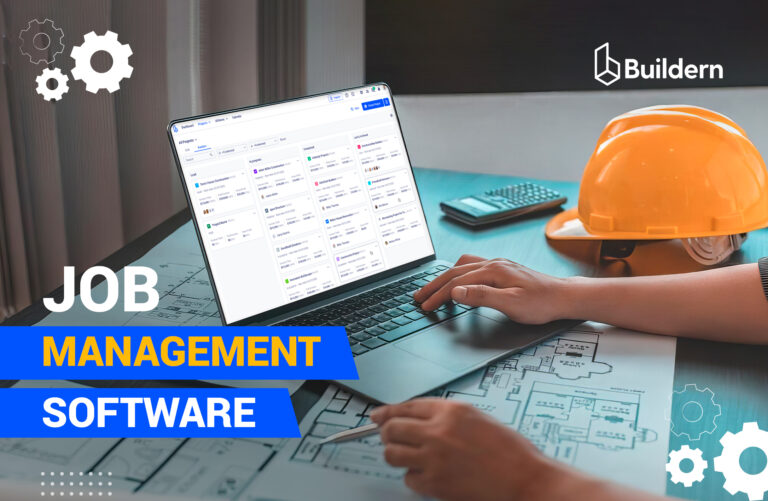7 Major Concerns Women in Construction May Have

Not long ago, the idea of women working in construction was not acceptable. However, this perception has changed significantly.
Women are increasingly stepping into roles once considered off-limits. This is relevant not only for fieldwork but also for engineering, project coordination, and leadership roles.
Besides, modern construction is no longer just physical labor. It’s a complex process with technologies involved. Construction project management has moved much further and now involves many office teams with both male and female workers.
In this article, we will examine the challenges women in construction face and the practical steps companies can take to break them down.
Table of Contents
- Women in Construction Today
- 7 Challenges for Women in Construction
- Benefits of a Diverse Work Environment in Construction

Women in Construction Today
Women are playing a growing role in the construction industry. However, they still represent a small portion of the workforce. For example, in the United States, the share of women is at just over 14 percent. At the same time, there is a positive trend as the number of women entering the field has increased over ten consecutive years.
However, there is still an imbalance between women working in the construction offices and the field. Most women in the industry work in office or administrative roles. Only a small share is involved in skilled trades or fieldwork.
There are also many organizations, conferences, and even awards specialized for women builders, which proves diverse environment has become more popular.
What may attract more women to the industry?
Labor Shortages: The construction industry is currently facing a significant labor shortage. At the same time, the number of jobs is growing and will continue to do so from 2023 to 2033. This means that now, more than ever, is the time to attract more women to construction and promote diversity.
Use of Technology: The increased use of technology in construction may also open more doors for women. The roles are becoming more flexible and less physically demanding.
But before accepting women to the team, the construction company must understand the everyday challenges women face in the field and in the industry in general.
7 Challenges for Women in Construction (And What Could’ve Been Better)

Most of the time, construction is a pretty tough place for women to work in. Let’s highlight some common challenges women encounter in the construction industry, along with solutions for each of the concerns.
1. Safety
The construction site definitely isn’t one of the safest places to work in. This industry accounts for the highest number of deaths. But the sad part is that it’s even less safe for female workers.
The thing is that many of the safety equipment and clothing must be precisely form-fitting for the employees to be effective. So, if they are wearing an oversized welder jacket, it does more harm than good, as it can easily be ignited during the welding routine.
As the percentage of women in construction is growing, the forms and safety equipment are becoming more widely adopted for female workers. However, many construction companies lack the apparel fit for women at the moment. This makes the construction field work extremely dangerous for women employees.
💡 Construction companies should work to provide the correct working suits and PPE for female employees. If not offered the right apparel and equipment, women employees should voice their complaints against the company.
2. Stereotypes
Most people think being a part of the construction industry means getting their “hands dirty.” Not anymore. Construction is not only about the demolition of buildings and bricklaying.
There are a number of jobs that do not even require you to be in the construction field, and yet, are crucial for the project’s success. You can be a part of the industry by being an architect, designer, construction manager, etc.
Many women are simply unaware that the construction industry has so many job possibilities for them. They imagine only physically demanding work when thinking of a job related to the construction sphere.
And with the modern digital construction management software, you don’t even need to step onto the construction site. All of the data required can be provided online so that you can oversee the entire process right from your computer.

💡The stereotype should be broken by raising awareness of the wide range of job opportunities and positions offered by construction companies.
3. Work Environment
Construction is considered to be one of the most gender-segregated fields. The vast majority of the building site workers are men.
Women are still afraid of some comments and inappropriate remarks at the construction site. Moreover, some say they do not do this job because of the fear of such comments related to their career choice.
💡Creating a more inclusive and respectful work culture must be a top priority. Construction companies should establish clear anti-harassment policies and provide regular diversity and inclusion training.

4. Lack of Amenities
Sadly, most companies’ failure to provide suitable working apparel is not the only problem. Most women in construction have to work in a different environment.
One of the examples is the lack of female restrooms and changing rooms. A very few of the restrooms at the construction site are designed to also meet female workers.
💡When building the working environment, construction companies should keep the needs of their women employees in mind.
5. Working After Maternity Leave
Maternity leave is one of the most significant barriers for women entering the construction sector. In the UK, for instance, the statistics show that only 15% of the construction companies give their female workers more than 18 weeks of statutory maternity leave, whereas the national average is 27%.
At the same time, in the United States, there is no such long period at all. Women have only
12 weeks of unpaid family leave time after the birth of their child.
💡Construction companies should start offering normal conditions for maternity leave and welcoming back their female workers once the leave is over.
6. Work/Life Balance
Balancing work and personal life is a challenge for many professionals. It can be especially difficult for women in construction. With seasonal work, long hours, and demanding timelines, construction jobs often leave little room for family responsibilities or personal commitments.
Many women in the industry report struggling to manage both roles effectively. Without flexible hours or remote work options, burnout becomes a real concern.
The challenge isn’t the workload itself, but the lack of flexibility and support.
💡Construction companies should find ways to make roles more flexible. This refers to offering flexible shifts, job-sharing opportunities, or remote project coordination roles if possible.
7. Lack of Career Advancement
Organizations supporting women in construction point to limited access to mentorship and career growth.
Since leadership roles are still predominantly held by men, women often miss out on the networking and guidance. This prevents them from advancing professionally.
This gap in support and visibility contributes to the gender imbalance at the top. This, in some cases, discourages younger women from entering or staying in the industry.
💡Building firms should actively implement mentorship programs that connect junior employees with experienced professionals, ideally women leaders, where possible.
Benefits of a Diverse Work Environment in Construction
Making the construction workforce more diverse means increasing the construction project’s efficiency. In an industry currently facing severe labor shortages, expanding the options is more critical than ever.
Meanwhile, a diverse workforce brings broader perspectives. Gender diversity helps fill roles, improves safety culture, and strengthens a company’s reputation.
Key benefits of women’s involvement in construction:
#1 Broader talent pool: Hiring more female construction workers will fill a gap amid the ongoing labor shortages.
#2 Better business performance: Gender diversity has a business advantage. There is a clear link between having a diverse workforce and company performance.
Besides, companies with more women in leadership tend to outperform their competitors. A key finding was that higher gender diversity on boards and executive teams has stronger financial returns.
#3 Improved working environment: With more women on the job site, there is more focus on communication and safety. Besides, this can lead to better conflict management and teamwork.
How many women work in construction?
The number depends on the countries and regions. As of 2024, women make up just over 14% of the total U.S. construction workforce. Meanwhile, in Australia, 74% of the construction workers are men. Although there has been an increase during recent years, most women still hold office or administrative positions rather than skilled trades or field roles.
What jobs can women do in construction?
There is a wide range of roles in the construction industry, far beyond traditional assumptions. There are women involved in office jobs in project management, quantity surveying, procurement, logistics, and administrative or financial roles. On the other hand, there are field trades like a plumber, electrician, carpenter, or equipment operator.
Is there protective gear designed for women?
Yes, there is special personal protective equipment (PPE) for women. It used to be a problem in the past, as there was no proper safety equipment. This often left women with oversized or ill-fitting protective gear. In addition to discomfort, this also posed serious safety risks. Now, PPE manufacturers suggest smaller safety gloves, boots, smaller hard hats, safety vests, and other equipment.
What are the best ways to support women in construction?
Supporting women in construction starts with an inclusive and respectful work environment. Mentorship programs, providing proper PPE, and equal opportunities for career growth are a great way to involve more women in construction. Retaining women in the industry is also important. Flexible work options or improving maternity leave conditions can improve the situation.



